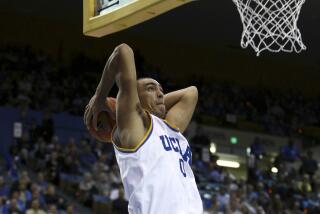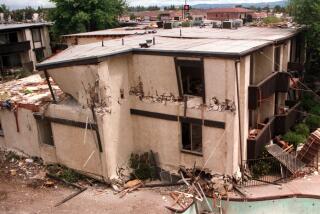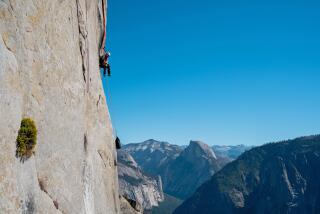A Test of Love
- Share via
One of the most enduring memories Craig Dobkin has of his brother Bruce never really happened.
It begins with Bruce riding a tricycle around a hospital floor. He peddles over to Craig, who is in an ICU bed. When Bruce gets closer, Craig whispers: “They’re trying to kill me here.”
“No, we’re trying to save you,” Bruce replies.
The recollection is more morphine than reality. There was no tricycle, but Bruce was trying to save Craig. And something, not somebody, was trying to kill Craig--a free fall from a Wisconsin cliff side.
“It’s a blessing that I can hardly remember anything,” said Craig, 49, of his 1995 mountaineering accident.
Bruce, however, is cursed with remembering almost everything. He remembers a phone call to his UCLA office. He remembers a plane trip to a small hospital in Green Bay. He remembers the quiet of the intensive care unit moments before laying eyes on the mangled body of his brother.
Most of all, he remembers the injuries. A concussion, a broken left hand, eight broken ribs, a cracked sternum, severely bruised lungs and a fractured vertebra.
“I remember walking out of the ICU and it was just before my mother was supposed to arrive,” said Bruce, 52. “I was crying down the hallway. It was just awful. Craig was so beat up. I just couldn’t imagine how I was going to show all this to my mother.”
More even than his brother’s doctors, Bruce understood the grave implications of the injuries, particularly the one to the spinal cord. Bruce is a leading neurologist and has cared for at least 100 other patients who had damaged their spinal cords as badly as or worse than Craig had. Bruce knew that even if his brother survived, he’d still probably never walk again.
“Most of the time I was acting as the doctor who happened to be the brother,” said Bruce, director of UCLA’s Neurologic Rehabilitation and Research Unit. “The rest of the time I was the brother who couldn’t believe what was happening to his younger brother.”
For both brothers, the tragic accident and the ongoing struggle for recovery has been a crucible of sorts. It has tested individual and family limits. It has left them, at times, bewildered, exhausted and hopeless.
But as sometimes happens under difficult circumstances, people meet a once-unthinkable challenge head-on, and transform the cruelty of irony and chance into a triumph of love and life. Such is the case with the Dobkin brothers.
It was a beautiful, brisk October day in Wisconsin. Craig, a veteran climber of some of the world’s highest mountains, was to teach a group of novices to rappel down a mountainside.
As a well-known advocate of programs like Outward Bound, Craig had led hundreds of student groups on similarly rugged trips. His programs, attended by everyone from corporate executives to battered children, were designed to foster self-reliance and teamwork.
“If I give you a fish, you eat for a day. If I teach you to fish, you eat for a lifetime,” said Craig in explaining the educational philosophy. “But here’s a third model: If I teach you to think, you don’t have to eat fish every day.”
As a standard safety precaution, Craig surveyed the area first. With his climbing ropes, Craig moved up and down the mountain to make sure the climb wasn’t beyond the group’s skill and also to clear the mountain face of any loose rocks.
The inspection seemed to be going fine. Craig returned to the top, took a quick break and prepared for another descent. What happened next nobody knows for sure.
Some say Craig was somehow distracted by the group. Others say Craig had been doing too much, had been too busy, and it was only a matter of time before he overlooked some small, but vital, detail. Craig says it could have been one of those or it could have been that he just slipped up.
“Setting up rappels is something I’d done hundreds of times before,” Craig said. “It’s a mystery how I fell. I gave up trying to figure it out a long time ago.”
As soon as Craig stepped backward off the mountainside, the anchoring ropes gave way. Ropes and spikes flew into his face. Craig tried to grab ahold of something, anything, but it was too late.
He fell 80 feet.
It’s incredible he didn’t die immediately. Bruce and other doctors believe it was Craig’s physical strength and agility that prevented him from breaking his legs or severing his spine at the neck.
But this wasn’t the first time Craig would pull himself out of a life-threatening situation. On Mt. McKinley, he’d gone snow-blind and weathered a storm for three days in a snow cave he’d carved. In the Himalayas, his lungs filled with fluid after suffering pulmonary edema at 21,000 feet, but he descended 2,000 feet--on his own power--to safety.
Perhaps most dangerously, Craig had silently wrestled with depression for most of his life. A few times he was suicidal.
It wasn’t until his early 40s that he found out why. He suffered from a chemical imbalance in his brain that caused radical mood swings. The condition is effectively treated with medication.
Now, at the bottom of a mountainside, he was alone again, unable to move his legs, bleeding and in great pain. Somehow, Craig managed to drag himself--leaving a trail of blood-- about 25 feet, around trees and boulders, onto a mountain-biking trail.
Luckily, a cyclist happened by on this otherwise rarely traveled path. Even luckier, the cyclist was an orthopedic surgeon. The surgeon called for help on his cell phone, tended to Craig’s injuries as best he could, and kept him still.
As they waited for help to arrive, the surgeon remembers Craig whispering that if someone would just turn him on his stomach, he could stand up and would be OK.
Hours later, an emergency room doctor phoned Bruce at UCLA, who was with a patient. He finished up with the patient, canceled his remaining appointments, and flew all night to Wisconsin.
This was not the first time Bruce had been shaken by news about a faraway family member. Less than a decade before, Bruce received a call from his aging father in Philadelphia. For years his father had been dogged by chronic neck and back pain, which was blamed on a fall he had taken on wet pavement. But on this morning, he phoned Bruce to complain of numbness in his right cheek. Suddenly, the other symptoms made more sense. The problem was not pinched nerves.
“I knew he had a [malignant] brain tumor,” said Bruce, who wrote about his father’s treatment and death in a book called “Brain Matters” (Crown Publishers, 1986).
Now, a decade later, Bruce would again have to be doctor and caretaker for a seriously ill family member. Upon arrival, Bruce rapidly took charge of his brother’s medical care.
Bruce pushed to transfer Craig to a more sophisticated medical facility at the University of Wisconsin at Milwaukee. He helped choose Craig’s surgeons and surgical techniques.
He phoned the neurosurgeons every couple of hours for status reports during Craig’s 10-hour spinal-cord operation, and then explained in layman’s terms the progress to his sister and mother.
On many occasions, Bruce interceded to spare Craig unnecessary pain. In one case, Bruce stopped technicians after they took three of 15 scheduled X-rays. He knew the crucial shots had already been snapped, and it was pointless to continue if Craig were in agony.
Still, there was little Bruce could do to manage Craig’s horrible pain. The worst of it came when Craig was placed on a ventilator. The machine, necessary to keep him alive and breathing, forced his lungs to expand against his cracked ribs.
“He’d been in some bad situations before, but he’d never known pain like that before,” Bruce said. “He would look up from his hospital bed and sort of give me this look like, ‘What’s going on?’ ”
As with his father, Bruce’s mother and sister provided invaluable support to him and Craig. But still, as the doctor, Bruce shouldered the greatest burden as his professional and personal life merged into one.
“I probably intimidated the house staff and nurses,” he admits. “But, after all, this was my little brother.”
After a couple of weeks, Craig’s life was no longer in danger, but his quality of life was. Craig had dropped 50 pounds from his 175-pound frame. His legs had atrophied into “sticks,” as Bruce put it. It took almost another month before he could even inch along in his wheelchair.
Next, Craig was transferred to a spinal-cord rehabilitation unit in his home state of Colorado. But his morale took an immediate hit when an orthopedic surgeon casually told him he’d never regain use of his legs.
Understandably, Craig was upset by this unwelcome news, but Bruce was furious at the surgeon’s poor bedside manner, and chewed him out for his tactless, and as it turned out, incorrect prognosis.
When conventional physical therapy couldn’t help him stand or walk, Craig visited Bruce’s clinic in March to experiment with a relatively new treatment for stroke victims and spinal-cord patients.
Bruce and other doctors believed that a partially damaged spinal cord like Craig’s could be retrained if it were carefully reacquainted with the walking motion.
Bruce had Craig put in a harness attached to an overhead lift, which placed him on a treadmill. Then, with some of his weight supported by the lift, Craig tried to mimic walking, with the treadmill set at a slow pace. Though his motion was crude, Bruce quickly realized Craig might have more usable hip muscles--essential for walking--than originally believed.
“It was klutzy, but he was doing it,” said Bruce, reviewing a videotape chronicling Craig’s progress.
With specially designed plastic ankle supports and months of hard work, Craig began to stand and walk again with just minimal aid from lightweight canes.
“He has always pushed the envelope,” Bruce said. “He’s pushed it further than any patient I’ve ever treated.”
Craig sums up his brother’s contribution this way: “I’m walking as well as I am today because of him. He saved my life.”
It seems as if now that Craig could walk, albeit with pain and some difficulty, the Dobkin brothers wanted to run. The accident and its aftermath merely provided the direction in which they would take off.
For Bruce, the accident sent him headlong into researching spinal-cord injuries like the one suffered by Craig and about 2,000 other Americans each year--the lofty hope being to regenerate nerve cells around the spinal cord.
In caring for his brother, Bruce had stumbled across a major gap in the medical literature about spinal-cord injuries. Almost all of it was devoted to mid- and upper-spinal cord injuries, not lower ones, such as Craig’s.
Bruce’s UCLA clinic is just months away from testing a new drug treatment that may regrow spinal-cord nerve cells, which, if successful, could improve a patient’s ability to walk. Tests on rats seem to offer hope that neurotrophic drugs could work on humans too. However, even if all goes well, it would be about five years before patients everywhere could benefit from the new technique.
But the accident too has affected more than just Bruce’s groundbreaking research.
“It allows me to empathize with families of patients with spinal-cord injuries,” said Bruce, who is married with twin teenage daughters. “I tell them about Craig, and for many I think it’s reassuring.”
Meanwhile, Craig’s ambitions are even greater, although some might say naive. But Craig has never been one to abide by the rules or the opinions of others.
Shortly after his accident, Craig, who is single, co-founded an organization called Play for Peace, whose goal is to build compassion and trust among youths around the globe. In pursuit of this dream, Craig has worked with gang members in Chicago, Palestinian and Israeli kids in the Middle East, and Serb and Croat teens in the Balkans.
By participating in cooperative games, where youths work toward a common goal rather than dividing up into winners and losers, Craig believes that kids can rise above their cultural differences and begin to see each other as human.
“Being disabled has allowed me to get places. It can bring out the best in people,” said Craig, whose program has drawn praise from former Jerusalem Mayor Teddy Kolleck and the M.K. Gandhi Institute for Nonviolence in Memphis, Tenn. “My task is to educate and have fun. It’s a great vehicle for compassion.”
Adds Bruce: “What he does is to try to keep children from repeating the sins of their fathers. What he does is more important than what I do.”
*
For more information about Play for Peace, visit its Web site at https://www.playforpeace.org.
* Martin Miller can be reached by e-mail at martin.miller@latimes.com.
More to Read
Sign up for Essential California
The most important California stories and recommendations in your inbox every morning.
You may occasionally receive promotional content from the Los Angeles Times.













